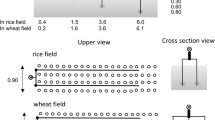Summary
Control of optimal soil water status for high productivity of cotton can be achieved more easily when the volume of the root system is restricted than with an extended root system. The restricted root system was obtained by planting on a pre-dried soil profile and by irrigation with a drip irrigation system applying small quantities of water at high frequencies. The effects of plant population, row and drip lateral densities and the amount of water per application, on soil water distribution and on cotton growth and productivity under these conditions were determined during 3 years of field trials. Cotton (Gossypium hirsutum L. cv. Acala SJ-2) was grown in a loess-brown loam soil in the northern Negev of Israel. The crop was planted on a dry soil profile between the end of May and early June and harvested during October and early November. There was no rainfall during the irrigation season. Water moved to a greater distance vertically than horizontally from the emitter, but there was no movement of water below a depth of 50 cm unless large quantities of water were applied. Maximal lint production was obtained within a narrow range of irrigation water quantities. Quantities below this range reduced production due to water stress, while quantities above this range enhanced vegetative growth and plant height and reduced lint formation. It was concluded that an optimal moisture regime can be obtained more easily by restricting the size of the root zone, but that over-irrigation may easily occur under such conditions. An increase in population over 10 plants/m2 resulted in enhanced vegetative growth associated with a reduction in lint yield with all irrigation regimes. At the optimal plant population and with maximum quantities of water applied, higher lint production and higher rates of water withdrawal were obtained at a row spacing of 50 cm as compared with 100 cm. When sub-optimal quantities of water were applied lint production was less reduced at row spacing of 100 cm. A row-to-lateral ratio of 2, and location of the laterals between alternate rows led to a greater vertical gradient in soil water content as compared with a row-to-lateral ratio of 1. Lint production was increased and vegetative growth was decreased at a row-to-lateral ratio of 2, at both row spacings of 50 and 100 cm.
Similar content being viewed by others
References
Bielorai H, Mantell A, Moreshet S (1983) Water relations of cotton. In: Kozlowski TT (ed) Water relations and plant growth. Academic Press, New York, p 49
Brandt A, Bresler E, Diner N, Ben-Asher Y, Heller J, Goldberg G (1971) Infiltration from a trickle source: I. Mathematical models. Soil Sci Soc Am Proc 35:675
Bresler E (1977) Trickle/drip irrigation: principles and application to soil-water management. Adv Agron 29:343
Buxton DR, Patterson LL, Briggs RE (1979) Fruiting pattern in narrow-row cotton. Crop Sci 19:17
Carmi A (1986) Effect of root zone volume and plant density on the vegetative and reproductive development of cotton. Field Crop Res 13:25
Constable GA, Gleeson AC (1977) Growth and distribution of dry matter in cotton (Gossypium hirsutum L.). Aust J Agric Res 28:249
Dasberg S, Bresler E (1985) Drip irrigation manual. Publ. International Irrigation Information Center (IIIC), Bet Dagan, Israel, No 9, p 1
Francois LE (1982) Narrow row cotton (Gossypium hirsutum L.) under saline conditions. Irrig Sci 3:149
Grimes DW (1977) Physiological responses of cotton to water and its impact on economical production. Western Cotton Prod Conf Proc, p 22
Grimes DW, Dickens WL, Anderson WD (1969) Functions for cotton (Gossypium hirsutum L.) production from irrigation and nitrogen fertilization variables. II: Yield components and quality characteristics. Agron J 61:773
Grimes DW, Miller RJ, Dickens WL (1970) Water stress during flowering of cotton. Calif Agric 24:4
Grimes DW, Dickens WL, Yamada H (1978) Early-season water management for cotton. Agron J 70:1009
Guinn G, Mauney JR (1984) Fruiting of cotton. I. Effects of moisture status on flowering. Agron J 76:90
Guinn G, Mauney JR, Fry KE (1981) Irrigation scheduling and plant population effects on growth, bloom rates, boll abscission and yield of cotton. Agron J 73:529
Howell TA, Davis KR, McCormick RL, Yamada H, Walhood VT, Meek DW (1984) Water use efficiencys of narrow row cotton. Irrig Sci 5:195
Jordan WR (1979) Influence of edaphic parameters on flowering fruiting and cutout. A role of plant water deficit. Proc Beltwide Cotton Production Res Conf, Phoenix, Arizona, p 217
Kittock DL (1979) Pima and upland cotton response to irrigation management. Agron J 71:617
Krieg DR, Sung FJM (1979) Source-sink relations of cotton as affected by water stress during boll development. Proc Beltwide Cotton Production Res Conf, Phoenix, Arizona, p 302
Lashin MH, Raafat A, Elkadi M (1970) Fruiting and shedding of cotton as influenced by irrigation frequency and nitrogen level. Z Acker Pflanzenbau 131:128
Marani A, Levi D (1973) Effect of soil moisture during early stages of development on growth and yield of cotton plants. Agron J 65:637
Plant Z, Mayoral ML, Rainhold L (1987) Effect of altered sink: source ratio on photosynthetic metabolism of source leaves. Plant Physiol 85:786
Shalhevet J, Mantell A, Bielorai H, Shimshi D (1981) Irrigation of field and orchard crops under semi-arid conditions. 2nd edn Int Irrig Inf Center, Israel
Shimshi D, Marani A (1971) Effect of soil moisture stress on two varieties of upland cotton in Israel. II. The northern Negev region. Exp Agric 7:225
Singh SP (1975) Studies on the effect of soil moisture stress on the yield of cotton. Indian J Plant Physiol 18:49
Stockton JR, Doneen LD, Walhood VT (1961) Boll shedding and growth of the cotton plant in relation to irrigation frequency. Agron J 53:272
Author information
Authors and Affiliations
Additional information
Contribution from the Agricultural Research Organization, The Volcani Center, Bet Dagan, Israel, No. 1781 E, 1986 Series
Rights and permissions
About this article
Cite this article
Plant, Z., Carmi, A. & Grava, A. Cotton growth and production under drip-irrigation restricted soil wetting. Irrig Sci 9, 143–156 (1988). https://doi.org/10.1007/BF00262356
Received:
Issue Date:
DOI: https://doi.org/10.1007/BF00262356




